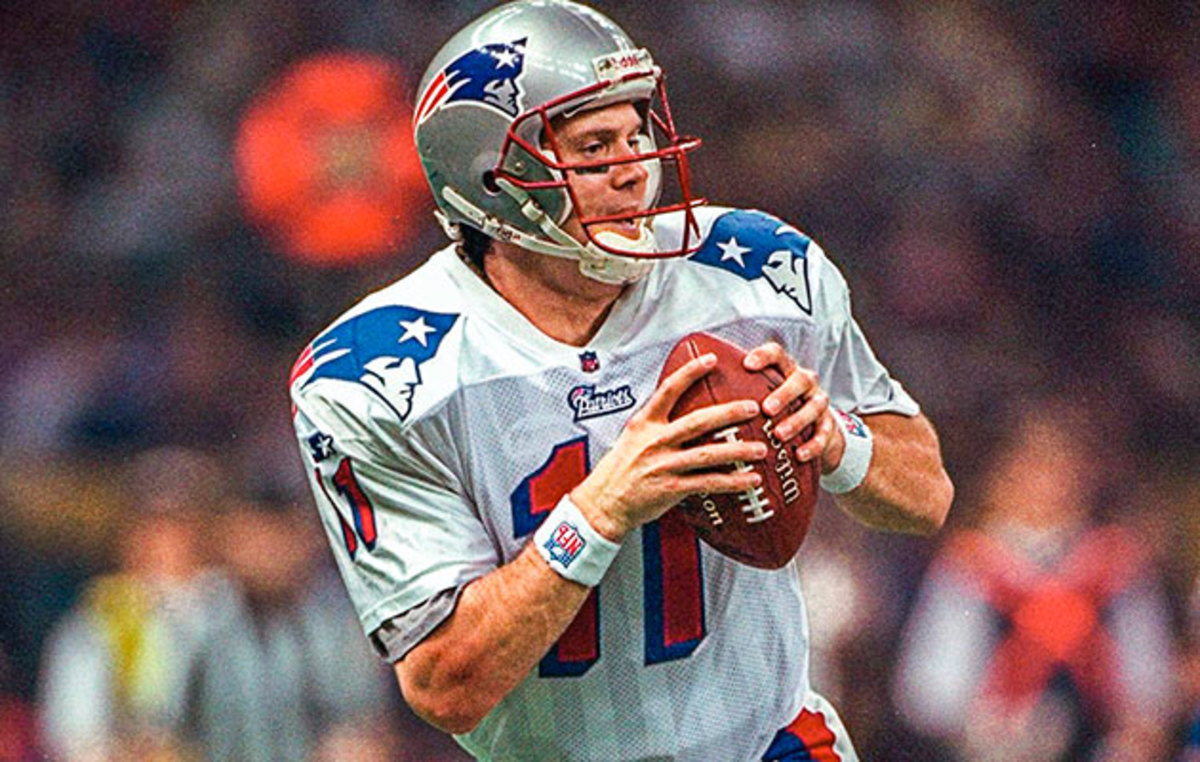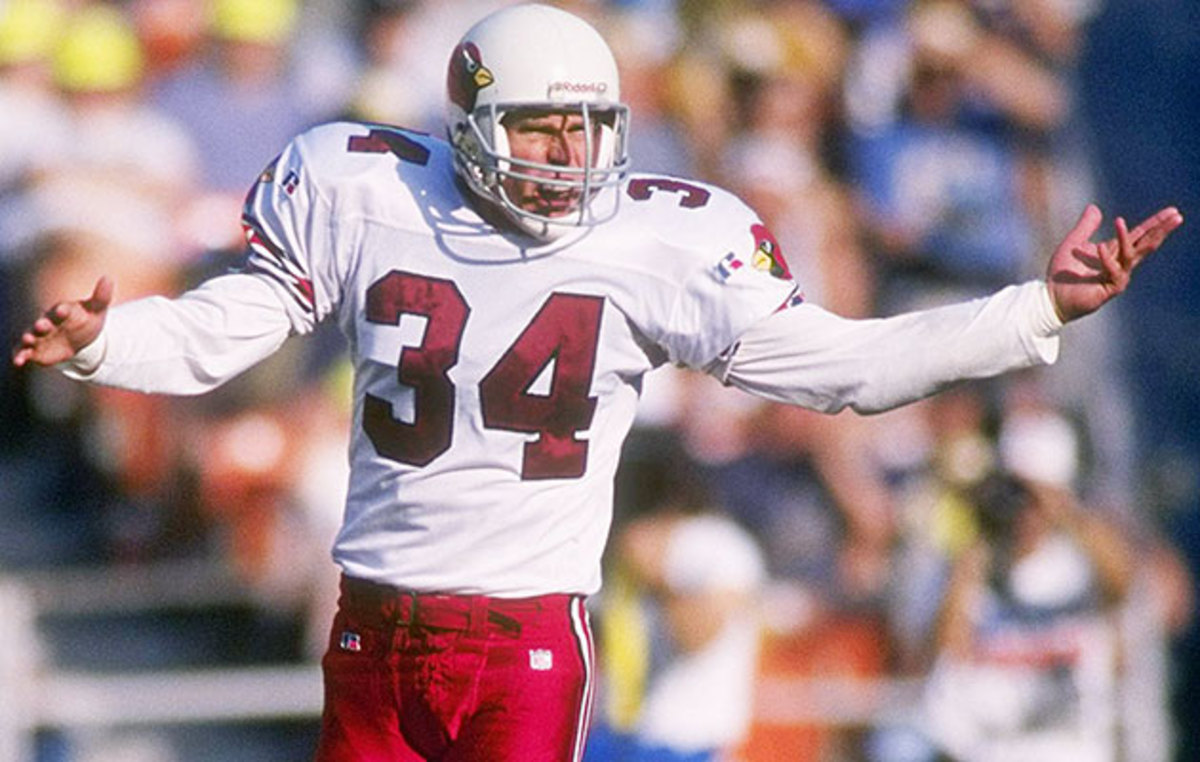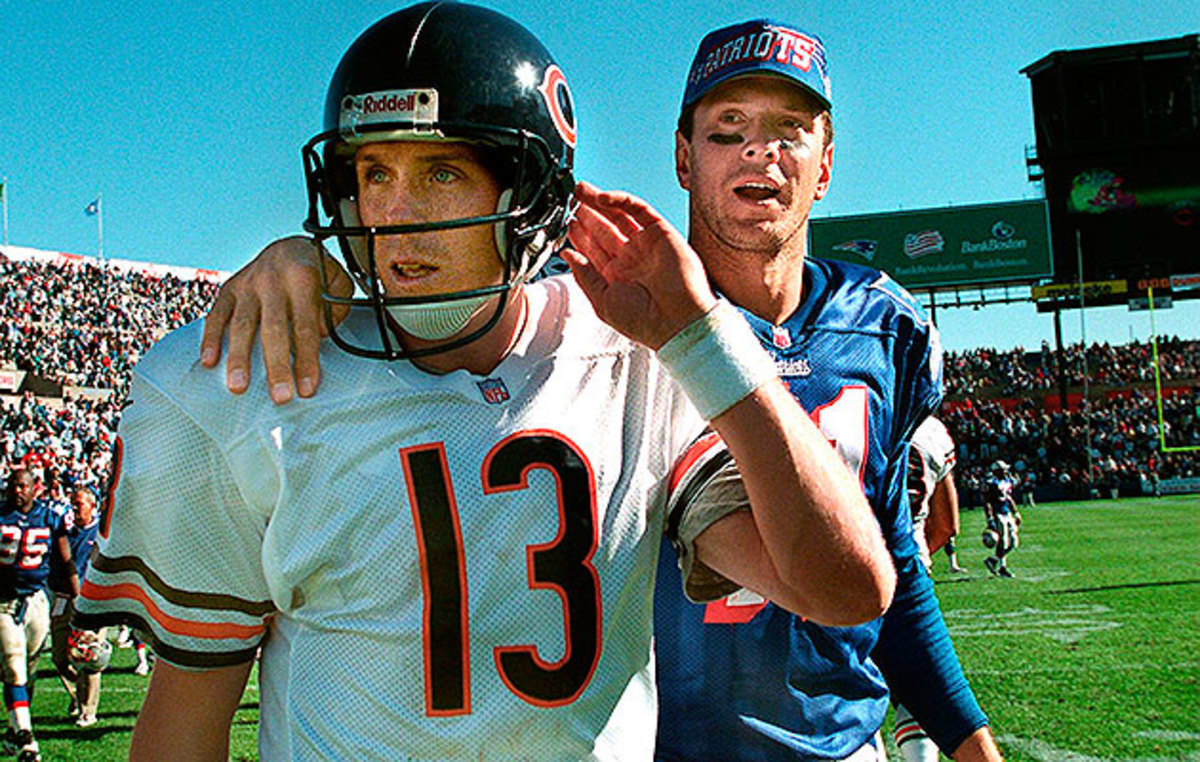Wine from Drew Bledsoe? Ex-athletes keep up competition at vineyards

From thetwirl of the bottle, to catch the drops at the end of each pour, to the playful I.D. check of the sexagenarian holding out a glass, Drew Bledsoe has the sommelier thing down pat. Standing behind the bar at Doubleback Winery’s tasting room in Walla Walla, Wash., the 6' 5" former NFL quarterback is surprisingly unassuming.
To be sure, he keeps a silver Sharpie within reach to sign bottles, and he poses for, or is stealthily captured in, dozens of photos every day. He autographs a jersey for a New Englander, who tells him he named his son Drew Adam (for Vinatieri, of course), and Bledsoe admits it’s not the first time he’s heard that.
But many of the oenophiles who bounce from tasting room to tasting room during Walla Walla’s annual spring release weekend are interested only in the wine—which, for many of the dozen former professional football players who have found their way into the business, is the dream reaction.
“It’s really good,” says Mckenzie Cordero as she works on her second glass of Healy Rosé poured by Bledsoe. “He was in the NFL? I thought he was just some nice tall guy.”

It’s nota straight line from the Bud Light–sponsored, sports-bar-viewed NFL to the cuverie, but Bledsoe is not the only retired player to have walked it. The 44-year-old former quarterback of the Patriots, Bills and Cowboys, who opened Doubleback in his hometown in 2008, insists that the transition makes sense.
“It’s just an extension of the competitive stuff we have done forever, without slamming our bodies against something,” says Rick Mirer, 46, who founded Mirror Wine Company in Napa Valley, also in 2008, after 12 NFL seasons at quarterback.
But why wine? “I think it’s the high-end thing,” Mirer says before adding with a laugh, “and there could be egos involved.”
Actually, Bledsoe and Mirer can thank ego for their separate ventures. Friends since predraft workouts in 1993—Bledsoe, out of Washington State, would go No. 1 to New England; Mirer, from Notre Dame, went No. 2 to Seattle—they considered purchasing a vineyard with Dan Marino and Damon Huard and calling it Rifle Arms Inc., but they quickly realized, as Mirer jokes, that there would be “too many quarterbacks in the huddle.” Marino, 54, and his Dolphins backup Huard, 42, started their own label, Passing Time, in Woodinville, Wash., in 2014. Now all four signal-callers are cooperating to put together a package to sell for the holidays, with a bottle from each vineyard.
Bledsoe and Mirer credit their friendship with pushing them toward the wine industry. They kept in touch after the draft, and one off-season they even took a joint vacation with their wives to Napa Valley. (At dinner after their recent SI photo shoot, Bledsoe opened the final bottle from a case of 1997 Saddleback Cabernet Sauvignon he bought on that trip.) “It’s pretty easy to fall in love with that kind of scene,” says Mirer. “Picnic lunch with world-class wines and a great view; I could get used to this real easy.” But as their tastes matured, they started seeking out quality.
Soon they discovered another way to one-up each other: exchanging the most obscure wines they could find. Once they exhausted the Washington and California options, they branched out. Mirer stumped Bledsoe with a dozen old-vintage Ports. “How do you find this stuff?” Bledsoe asked. He got Mirer back with a case of late-’90s Brunello di Montalcino, from Italy.
After retirement they joined the crush of former athletes—a disproportionate number of them football players—who have gone from mispronouncing Cabernet to having a stake in a winery: Among others, there were the NFL’s Dallas Clark, Mike Ditka, Alphonse Dotson, John Elway, Terry Hoage, John Madden, Joe Montana, Dick Vermeil and Charles Woodson; golfers Jack Nicklaus, Greg Norman and Arnold Palmer; auto racers Mario Andretti and Jeff Gordon; hockey icon Wayne Gretzky; Hall of Fame pitcher Tom Seaver; Naismith Hall of Famer Yao Ming; and figure skating gold medalist Peggy Fleming. It would be possible to fill an entire cellar with sports figures’ wine.
The question of how closely to tie their first career to their second can be tough. Should they use the marketing value accrued over years in the public eye and take the risk that people would write them off? Or, rather than rely on their famous names, should they try to learn the business from the bottom up?
“The first time you drink it, it’s because it’s Mike Ditka’s wine,” says Ditka, who partnered with Terlato Wines in 2012, after a Hall of Fame career as a tight end and 14 years as a head coach. “The second time it’s because it’s good.”
Huard and Marino took the opposite approach. Their names are not on the label; the only nod to their past lives—other than the wink of Passing Time—is in the eight stitches subtly incorporated into their logo. “It’s not a vanity project,” says Huard. “We like to think people who don’t know football might ask, What are those markings?”
Nearly all of the jock vintners use that phrase, vanity project, as in, “This is not a. . . .” Some experts disagree: “We can call it winemaking,” says James Lapsley of the UC Davis Department of Viticulture and Enology, “but really, what most rich people do is hire other individuals to produce the wine and make the technical decisions. The owners are buying a lifestyle.” Still, the industry welcomes their star power.
“It’s such a great boost” when former athletes get involved, says Steve Burns, a former executive director of the Washington State Wine Commission who now runs a consulting firm. “I don’t know that it’s possible to measure it, but it brings a new audience to wine.” Yao opened Yao’s Family Wines, based in Napa, in 2011; the organization is now the biggest seller of high-end California wine by value in China, the fifth largest red-wine market in the world.
“In the early days I think people were skeptical of these guys’ intentions, but we’ve seen so many success stories,” says Burns. “If you’re willing to do the whole thing, stand behind a table at a wine tasting, then let’s go.”
And many of them are willing. The depth of involvement by former athletes varies: Marino jokes that his title at Passing Time is “social director and drinker,” but Bledsoe fusses over label designs, Mirer packs boxes during the holidays and Huard makes most deliveries in his 2004 Escalade. And they all express awe at Hoage.

Having grown up in a family of teetotalers, Hoage had his first sip of alcohol when he arrived on campus at Georgia. Beer, of course. His tastes didn’t change much during his first years as a safety in the NFL, with the Saints. His first date with his future wife, Jennifer, then a dining editor for New Orleans Magazine, was at a wine bar—but he ordered a beer.
Eventually she brought him around, and when they bought a property in Paso Robles, Calif., that included a 26-acre vineyard as a decorative element, a friend introduced them to Justin Smith, a wine industry star. Hoage, now 54, realized that the wine-growing lifestyle—working hard, spending time outdoors—appealed to him, and he asked Smith to make wine from his property. Hoage spent two years following Smith around, “cleaning stuff and asking a bunch of stupid questions,” before setting off on his own in 2004.
The man who once described a wine as smelling just like the Paso Robles Big Brand Tire store now refers to himself as a vigneron, a French term for a winemaker who controls the entire process from seed to bottle. (For the record, Hoage was right, even if he didn’t know it at the time; faults in winemaking can produce mercaptans, which give off a rubbery odor.) He bounces from TH Estate Wines’ vineyard, where he might trim the vines or dispatch a pesky gopher, to the cellar, where he samples wine from one barrel and compares it with the contents of its neighbor. At his office, he examines root stalks and pores over irrigation-system designs. Other than one employee who helps him in the fields and three or four who work in the tasting room, the 2,500-case-a-year operation is an all-Hoage affair. Jennifer manages sales and the tasting room there.
But the more Terry works at his craft, the more he realizes how much there is to learn. Having majored in genetics at Georgia, where he had a 3.85 GPA, he thought he would be prepared for his new career. He pulled out his old textbooks—Fundamentals of Biochemistry, Microbiology—and lined them up on bookshelves in the winery’s office . . . where they remain, collecting dust. “There’s science,” he explains, “but it’s more like cooking than anything scientific.”
For Mirer the education was part of the allure. Long before he considered going into the business, Mirer ignored the movie-watching and card-playing on team flights and instead delved into back issues of Wine Spectator and Robert Parker’s Wine Advocate.
“What makes a Bordeaux a Bordeaux?” Mirer remembers learning. “Why is Pinot Noir such a finicky grape? Why do you chill white wines? There was so much depth to it, and it was so completely unrelated to football. I just couldn’t get enough.”

For decades athletes have attached themselves to ventures in the food industry—Joe Theismann’s restaurants, Refrigerator Perry’s Bar-Be-Que sauce, George Foreman’s grills. As the American food-and-beverage culture explodes (in 2009 the U.S. became the largest worldwide consumer of wine), and as team nutritionists introduce their charges to fresh, seasonal food, a foray into viticulture is a natural next step. The prestige element is also key; this boom has not been mirrored in athlete-created beer.
Woodson, who owns Charles Woodson Wines in Napa, first became interested in wine as a young player trying to fit into a culture completely foreign to him. “It was a different take on drinking than I was used to,” he says. “I didn’t even like it that much, but I wanted to be a part of the whole thing.”
“The NFL football player today is a far more sophisticated person,” former coach Vermeil says. “He has more money, he goes to high-end restaurants, and he develops a taste for quality wines.”
That was certainly the pathway for Bledsoe. As he became more interested in wine, he started hosting regular blind tastings for his Patriots teammates, and he noticed that Walla Walla Cabernets kept winning. Maybe there is something real back in my little town, he thought. (Doubleback is a reference to his return home.)
Now he drives to his 26-acre estate up the dirt roads on which he used to go brake sliding as a teenager in his Volkswagen Rabbit. Doubleback grows mostly Cabernet Sauvignon, along with some Merlot, Petit Verdot and Malbec, four of the six grapes allowed in Bordeaux reds. (Those grapes also thrive in Napa Valley, but because Walla Walla’s terroir—climate, soil, topography—resembles that of Bordeaux, the Washington wines are more savory and nuanced than the fuller-bodied “California Cabs.”) And the results are good. Wine Spectator rated Doubleback’s first vintage, released in 2010, at 95 on a 100-point scale and listed it among the magazine’s top 100 wines in the world that year. Under the guidance of Josh McDaniels, who last year took over for his mentor Chris Figgins, Bledsoe’s childhood friend (and conveniently among the most respected vintners in Washington), Doubleback has shown no signs of slowing down.
Sitting on the edge of a stone fire pit overlooking his McQueen vineyard, Bledsoe is animated as he points to his other vineyard, 500 yards to the east. “The soil on that vineyard is totally different from this soil,” he says eagerly. “This is wind-blown loess, so the soil up here actually was truly blown out of the valley and into the desert, like a sand dune, probably 10,000 to 15,000 years ago, not very long in geologic time, but then the soil over there is glacial flood deposit silt loam . . . . ” He catches himself. “Sorry,” he says, “wine dork.” And then he rushes headlong into a brief geological history of the Pacific Northwest from the last ice age until now.
Later he heads over to that glacial flood deposit silt loam vineyard, where he becomes nearly giddy describing how Doubleback cleared out the Tempranillo vines last year, replacing it with a more marketable grape by cutting down the vines and splicing a Cabernet clone into the existing roots. “And because of its established root structure, it pushes so much energy into that vine that a year later that brand-new vine will produce fruit!” he finishes brightly. “Isn’t that cool?”
In that moment Drew Bledsoe is almost unrecognizable as the man who was the youngest quarterback to make the Pro Bowl, who led the 1996 Patriots to the Super Bowl, who helped lay the foundation for a New England dynasty. Standing between two rows of vines, pulling at the leaf canopy to get a look at how the grapes are coming in, expounding on viticulture, he just looks like some nice tall winemaker.
